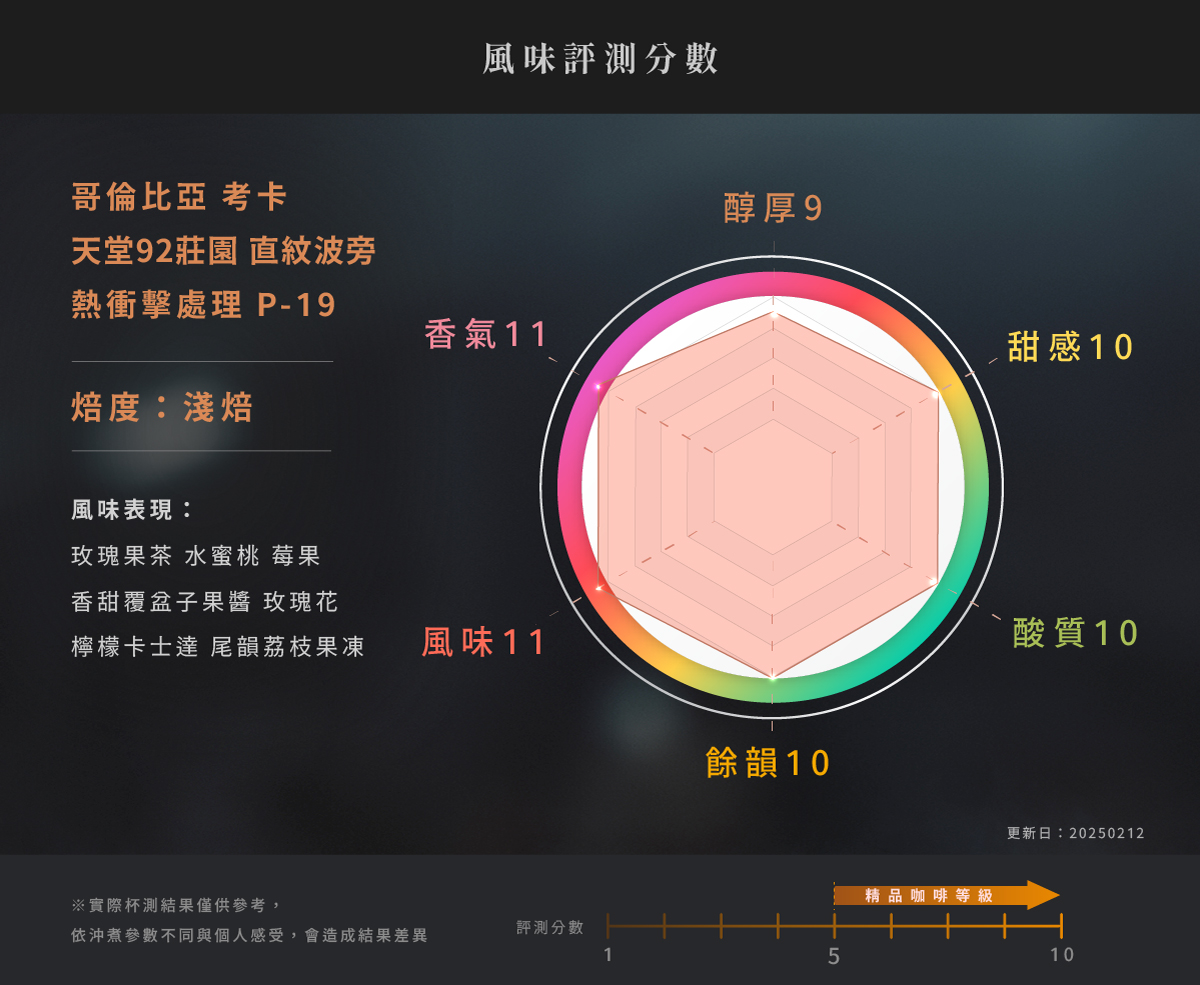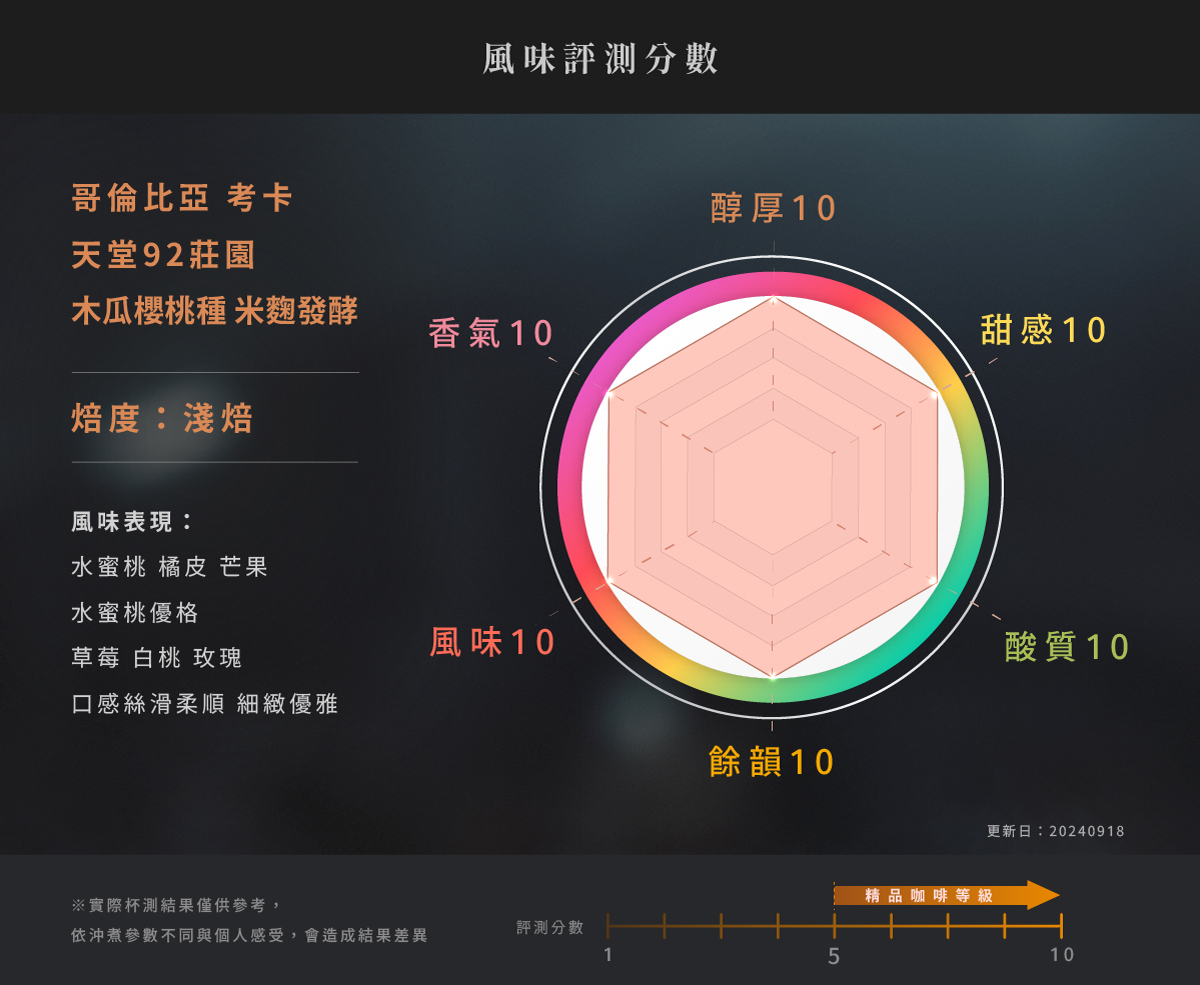

Colombia Granja Paraiso 92. The options are as follows:
Colombia Granja Paraiso 92 Striped Bourbon Thermosock P-19


-------
Colombia Granja Paraiso 92 Papayo Kōji process

Colombia Granja Paraiso 92 Yellow Geisha Double Anaerobic Fermentation
Colombia Granja Paraiso 92 Red Bourbon Thermo sock TS DF Sugarcane DECAF
Paraiso 92 Estate Awards Record:
1. 2023 - Coffee Review International Coffee Evaluation: 94 & 96 points
2. 2022 - Barista national championship coffee sponsor- 1st Place
3. 2022 - International Coffee Awards Australia - 1st Place
4. 2022 - Golden Bean USA - 1st Place
5. 2022 - Best Cauca Coffee - TOP 10
6. 2021 - Coldbrew National Championship USA - TOP 10
7. 2021 - Coldbrew National Championship Colombia - 1st Place
8. 2021 - Best Cauca Coffee - TOP 10
9. 2019 - Colombia Land of Diversity - TOP 10







Coffee Flavor
The flavors of coffee are derived from the breakdown of various nutrients in the green coffee beans during roasting. Heat causes these compounds to degrade into a variety of aromatic molecular structures, resulting in a wide spectrum of flavors. High-quality coffee beans naturally possess a rich aroma that evolves at different temperatures—high, medium, and low—offering a delightful and nuanced experience worth savoring.
Colombia Granja Paraiso 92 Striped Bourbon Thermosock P-19
Rosehip Tea, White Peach, Berries, Sweet Raspberry Jam, Rose, Lemon Custard, Lychee Jelly Finish
-----
Colombia Granja Paraiso 92 Papayo Kōji process
Peach, Orange Peel, Mango, Peach Yogurt, Strawberry, White Peach, Rose; silky and smooth mouthfeel, delicate and elegant
-----
Colombia Granja Paraiso 92 Yellow Geisha Double Anaerobic Fermentation
Rose Milk Tea, Peach Yogurt, Strawberry Jam, Bergamot, Banana Chocolate
Colombia Granja Paraiso 92 Red Bourbon Thermo sock TS DF Sugarcane DECAF
Sugarcane, Ginger Sugar, Orange Juice, Cranberry, Cherry, Brown Sugar Ginger Tea, Sugarcane Juice

Granja El Paraiso 92—often referred to as Paraiso 92 Estate—is far more than just a coffee farm; it embodies a deep exploration and continuous innovation in post-harvest coffee techniques. This family-run farm employs highly innovative cultivation methods, including terraced planting, drip irrigation, shading, and laboratory-based nutrient calculations. They produce a variety of coffees—such as Jave, Pink Bourbon, Geisha, Pacamara, Caturra, Tabi, Castillo, Colombia Supremo, and more—aiming to create truly one-of-a-kind coffees that have earned numerous awards.
Renowned for its experimental spirit, Paraiso 92 Estate spares no effort in coffee cultivation. It boasts its own microbiology lab, quality control lab, and processing facilities. From strict green bean selection and disinfection to identifying the characteristics of each coffee cherry, they tailor the ideal processing method for each variety.
Paraiso 92 Estate is located in the 考卡省Cauca region—one of Colombia’s most renowned specialty coffee-producing areas—on the southwestern side of the country. Flanked by high mountains to the east and the Pacific Ocean to the west, this unique geography, coupled with cooler temperatures, proximity to the equator, and the protective conditions provided by the surrounding mountain ranges, creates an ideal environment for coffee cultivation in Cauca.

Paraiso 92 Estate strictly controls the fermentation environment of green beans and selects specific microorganisms for the process, ensuring each batch of coffee beans boasts bright and distinctive fruit flavors. The estate is dedicated to applying these fermentation techniques to a wider range of coffee varieties, continually exploring new potential flavor profiles.
Arabica Coffee Variety – Bourbon
It is one of the coffee varieties closest to the original native species, first discovered on Réunion Island (formerly known as Bourbon) near Madagascar.
The Bourbon variety has its own distinct characteristics and shares a high-quality flavor profile similar to Typica, featuring wine-like acidity and a sweet aftertaste. Bourbon and Typica can be distinguished by their leaf shape and bean appearance—Bourbon trees have broader leaves, and their coffee cherries are smaller but grow more densely. As a result, Bourbon beans tend to be smaller and rounder compared to Typica.
In Kenya and Tanzania, Bourbon descendants were selectively crossbred, leading to the development of the renowned SL28 and SL34 varieties, which are highly prized for their exceptional flavor profiles.
While Bourbon has a slightly higher yield than Typica, its harvest cycle remains two years, making it a low-yield variety overall.
Striped Bourbon
Striped Bourbon is an unusual Bourbon variety discovered in recent years in the Huila region of Colombia. It was first identified by the Australian Project Origin team and is now cultivated by Cesar Morales at La Palma farm. This variety is distinguished by its striking yellow stripes on red coffee cherries, which enhance its floral aroma and sweetness. Inspired by this unique appearance, the farm owner named it Striped Bourbon.
Arabica Coffee Variety – Papayo
Discovered in Acevedo, this is considered a new variety often thought to be a mutation of Caturra. However, according to tests by World Coffee Research, Papayo’s genetic sequence is actually closer to Ethiopian landrace varieties. How an Ethiopian plant suddenly appeared in the small town of Acevedo in Colombia’s Huila region remains a mystery. Papayo coffee cherries are uniquely elongated, turning orange when fully ripe, and they carry a subtle papaya-like aroma—hence the name. Its flavor profile is notable for a full, sweet taste that sets it apart.
Arabica Coffee Variety – Geisha Coffee
Once named by Forbes as one of the “Top Ten Most Expensive Coffees in the World,” Geisha coffee is considered a legend in the specialty coffee community. However, there is significant confusion surrounding the Geisha variety because multiple genetically distinct plant types are referred to by this name, many sharing a similar geographic origin in Ethiopia. Recent genetic diversity analyses by World Coffee Research confirm that the T2722 variety grown in Panama is both distinct and consistent. When cultivated under proper management at high altitudes, it shows a strong correlation with exceptionally high cup quality, known for its delicate floral, jasmine, and peach-like aromas.
Regarding its name, “Geisha” and “Gesha” are often used interchangeably. This is related to transliteration, as there is no fixed method for translating from Ethiopian dialects into English. Initially, it was recorded in cultivation records as “Geisha,” and for decades, most coffee researchers and origin databases maintained that spelling, leading to its widespread adoption within the coffee industry. The variety was originally collected from a mountain in Ethiopia, whose name is generally rendered in English as either “Gesha” or “Geisha.”
In recent years, the Geisha variety has been cultivated worldwide and has achieved outstanding results in numerous competitions, including those in Guatemala, Costa Rica, El Salvador, Colombia, and Peru in Central and South America—most of which involve transplanting Panama’s T2722 variety. Taiwan has also begun growing Geisha in many high-altitude regions, generally producing more captivating flavors as the elevation increases.
------

(Coffee Processes)
This refers to the process of transforming ripe red coffee cherries into dried green beans. Each processing method has its advantages and disadvantages, influenced by the natural environment and the specific needs of each region. As a result, different origins employ processing methods best suited to their conditions. This particular batch of green beans uses the Double Anaerobic Method, the Koji Fermentation Method, or Sugarcane Decaffeination, outlined below:
【Thermo sock】
By rapidly exposing coffee cherries to a high-temperature environment, the naturally active enzymes are immediately deactivated, effectively halting uncontrolled biochemical reactions and microbial activity. This process achieves a sterilization effect, laying a stable foundation for subsequent processing steps.
Additionally, the heat treatment softens the coffee cherries, increasing their density and monosaccharide content. These changes not only facilitate the washing and drying process but also create ideal conditions for balanced fermentation.
Next, specialized microorganisms are introduced, serving as the key secret to the entire processing method. These carefully selected microbes precisely guide the fermentation process, further enhancing the complexity and stability of the coffee’s flavor. As a result, the final coffee beans exhibit richer, more balanced, and well-defined flavor layers.
【Kōji process】
Kōji is a microorganism derived from Japanese fermentation techniques, traditionally used to ferment soybeans for making soy sauce and miso. With advances in post-harvest technology, it has recently been applied to coffee fermentation, enhancing both body and sweetness in the cup.
Discovered on Réunion (formerly known as Bourbon) near Madagascar, Bourbon is recognized for its distinctive characteristics and high-quality flavor—often described as having wine-like acidity with a sweet aftertaste. Compared to Typica, it can be identified by its broader leaves and its smaller, more densely clustered cherries, which produce beans that are slightly smaller and rounder. Hybrid descendants of Bourbon, such as SL28 and SL34, were developed through selective breeding in Kenya and Tanzania and are renowned for their excellent flavor profiles. Although Bourbon typically yields slightly more than Typica, it still follows a two-year harvest cycle and is considered a lower-yield variety overall.
【Anaerobic】
In a sealed container filled with carbon dioxide, creating an oxygen-free environment, ripe coffee cherries are placed in low temperatures to slow the breakdown of pectin sugars. The pH level also drops more slowly, extending fermentation time and allowing for better sweetness and a more balanced flavor to develop. This slow and prolonged fermentation increases roundness in the cup, avoiding unpleasant dryness and acetic notes; meanwhile, the sealed fermentation environment helps preserve volatile aromatic compounds.At Paraiso 92 Estate, their Double Anaerobic process begins with ozone and hot water sterilization of the beans (to reduce enzyme activity and maintain favorable microbial control), followed by whole-fruit fermentation. Once fermentation is completed, the cherries are de-pulped. Specific microorganisms are then introduced for another round of anaerobic fermentation before the beans undergo washing and drying. This anaerobic method enhances the coffee’s sensory profile, resulting in uniquely rich and layered flavors in every batch.
【Sugarcane DECAF】
The green coffee beans are first soaked in warm water to release their internal caffeine. They are then introduced to an ethyl acetate solution derived from sugarcane, which removes about 90% of the caffeine. Following this process, the beans’ original caffeine content of 1.08% is reduced to approximately 0.029%—effectively removing about 97% of the caffeine.





JUSTIN INTERNATIONAL FOOD ENTERPRISE CO., LTD.
Tel: +886-3-358-6611
1st Floor, No. 30, Lane 120, Daxing Road, Taoyuan District, Taoyuan City
▶This product is covered by a NT$10 million product liability insurance.
▶Food Industry Registration Number: F-165601955-00000-0
▶ Our company’s cupper is certified as a CQI International Coffee Quality Appraiser.



Recommended Product



